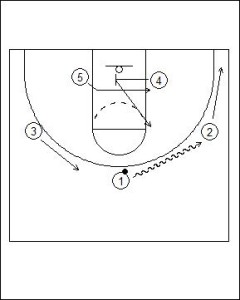Zipper Offense: High/Low
The Zipper Offense is very effective against high-pressure defences in allowing players to run off of multiple screens to create space and achieve good receiver positioning. The Zipper offense will also assist in creating mismatches if the defence employs the tactic of switching on screens that is a very common defensive tactic against the offense and the Zipper Cut.
The Zipper Offense High Low Play looks to move perimeter players using the Zipper Cut, but also exchange interior players through a series of down screens. This continuous movement helps keep defenders in constant motion, but also plants the seeds of advantage through screening in and around the keyway.

The formation for The Zipper Offense High Low Play is 3 Out and 2 In. To help extended the areas that the defensive players need to cover both post players (Four and Five) should start in line with the backboard.
The Zipper Offense High Low Play begins with One (1) dribbling the wing position on either side of the floor. The offensive player in this position (Two) moves to the strong side long corner.
As the dribble is started by One (1), the strong side low post (Four) screens across for the weak side offensive player (Five).
After Five (5) has utilised the screen then Four (4) flashes to the strong side high post.
Three (3) looks to lift to the weak side elbow extended.
Variation:
If both post players (Five and Four) are denied a pass then the ball can be skipped to Three (3) for a quick pass into the post for an interior scoring opportunity.
Scoring Options:
- Four (4) on the screen and deep seal; in this movement Five (5) would continue to move into a mid-range position
- Five (5) following the cross screen

Two (2) now executes the Zipper Cut and moves under the two post players Four (4) and Five (5).
Two (2) lifts up the inside of the keyway and finishes on the strong side of the point position. This is an important position, as the defender will have less opportunity to slip off in the trail and deflect the pass back to Two (2).
One (1) should initially look at a post entry pass into Four (4) or Five (5). If no pass is suitable then One (1) reverses the ball back to Two (2).
Three (3) re-positions to the weak side foul line extended. This extends the space for Three’s defensive match-up to move in help defence. In this position should the ball be reversed quickly on by Two (2) this will see Three (3) isolated and have a strong driving lane to the basket. When driving Three (3) will also have receiver spots already filled by Four (4) and Five (5).
As Two (2) moves past Five (5), Five (5) then looks to set a screen for Four (4).
Four (4) lifts to where the split line and foul line intersect. This gives good balance to the intended high/low step-up between Four (4) and Five (5).
Scoring Options:
- Post entry pass into Four (4) or Five (5)
- Two (2) on Zipper Cut
- Four (4) on the flash to the foul line
- Five (5) on the screen and seal
- Three (3) on reversal and isolation

If the pass is made by Two (2) into Four (4) then the high/low game begins for the two interior players (Four and Five).
If the pass is made inside then Three (3) will sink to the long corner. This will allow the post players to make a pressure release pass and reset for a new interior target position.

If the pass cannot be made into an interior target then the play can start again with the player in the point position (Two) can dribble to the wing position.
Four (4) moves across to the strong side high post.
Five (5) flashes to the strong side low post.
Three (3) will now prepare to make the Zipper Cut.








Leave a Reply